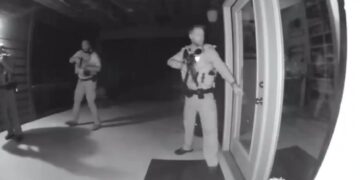By John F. Di Leo -
On Wednesday, February 21, a bus tumbled over a cliff in Peru, killing at least 44 passengers. The bus was traveling on a narrow but important highway, the Pan-American Highway in the state of Arequipa, and the news horrified the nation, as it came less than two months after another almost-identical bus crash on January 2, also killing dozens of victims, on the same stretch of highway, an area so serpentine that sections are known by names like “Devil’s Curve.”
Such events occur on a daily basis in the third world, but rarely make the international news. Much of the world is arrayed with crumbling infrastructure – from weak bridges to pothole-ridden roads – so traffic accidents, caused not by driver error but the inherent danger of the road, is commonplace.
In the case of the Pan-American Highway, however, we’re talking about a major thoroughfare, one which, despite being only one lane in each direction for much of its most dangerous route, is an important highway, generally running parallel to the Pacific coast for much of Peru. It has the occasional sign – “Drive Carefully!” – but no guardrails, or width, to help people accomplish such a worthy goal.
Now, these aren’t cars in private hands here. We are talking about vehicles that are – in our legal system – referred to as “common carriers.” They are companies that operate as professionals, presumably with better drivers, better equipment, and more safety-oriented practices, than the average individual might. Faced with the charge of traveling on such narrow, scary mountain roads, who could blame a person for saying “I’ll leave my car in Huacho, and take the bus to Lima. Better to trust the experts than to try navigating such topography myself!”
And for such a choice, dozens lost their lives in the senseless tragedy of a bus crash, hundreds of feet down a cliffside.
Thousands ask themselves: What can we do? What should we do? How can we prevent such an accident in the future?
There are plenty of data points, and the investigations have begun.
In South America in particular, there are good drivers, and there are bad ones. One of the drivers had let his permit expire, but don’t be too sure that’s it; other drivers who’ve tumbled off the Pan-American Highway have been up to date.
Some of these buses are rickety old things, but don’t be too quick to blame the equipment; there are also crashes involving modern cars in good condition.
Some of the vehicles were overcrowded (the January 2 bus had 57 passengers besides the driver and crew member), but vehicles have also crashed that had no more passengers than published capacity.
And the January 2 bus was reported to have hit a trailer being hauled by another vehicle – on a road particularly precarious for such types of vehicles – but other crashes on this dangerous road have been one-vehicle accidents… that is, no other vehicle of any kind could be blamed.
Maybe it’s just a dangerous stretch of road?
In fact, Gentle Reader, there is little doubt that the ideas that come to your mind while you read this piece are among the logical steps that Peru should indeed take. More forceful limits of the capacity of a single vehicle, restrictions on segmented vehicles (like tractor trailers or trucks hauling campers), lower speed limits, greater driver training. There are plenty of possibilities, if we leave personal politics out of it, and focus on measures that may genuinely make the road safer. No individual measure will end every threat, but progress can be made, incrementally, to increase safety and reduce horrific incidents on the highway.
But the Gentle Reader will also note that, no matter what measures we take, there is a limit to how safe we can ever hope to make a serpentine cliffside highway on the bank of an ocean, one so narrow there’s only one lane in each direction. There is a limit to how safe you can ever make a road like this. Almost any kind of incident on such a road has the potential to produce fatalities.
So the true solution must include widening and straightening of the road, and the addition of guard rails, fences and walls. There are stretches where they should punch a hole in the mountain and tunnel their way through, because the route around the mountain will just always be too treacherous, no matter what.
No, there is no one answer. The solution is a combination of many measures – some cheap and some pricey – and Peru can never hope to reach a 100% safety level. But surely, with common sense and a little wise spending, they can make their highways much safer than they are today.
A Parallel in Parkland
There are plenty of differences between the Peruvian coastal crashes and the Valentine’s Day murder rampage in Parkland, Florida. The one was an accident; the other was homicide. One involved guns and the other a busl; one took place on a government road and the other took place in a government school.
But there are striking similarities as well. Just as the Peruvian crashes involved years of neglected warnings, poor design and the wrong staff, so too did the incident in Parkland show that many common-sense warnings were evaded, so none of the tools society has to protect itself was given a chance to work.
There will always be calls for draconian solutions – ban buses, or ban public transportation… but millions use public transportation successfully every day; our economies depend on it. Or ban gun ownership or ammunition purchases… but millions own and use guns for legal and honorable personal use every day, for self defense, for hunting, for target practice. The very existence of buses prevents a lot of accidents that would otherwise take place if those people were in cars; the very existence of rifles in private possession prevents and foils lots of crimes, infinitely more than the crimes in which they are used by the perpetrators. So, no, outright bans of these things don't end the threats.
So society's challenge is to study these incidents and find the specific flaws in our system that we can repair, the specific failures that, if fixed, could make such incidents rarer, and less fatal when they do tragically occur.
In the days since the killings at Marjory Stoneman Douglas High School, consider the shocking things we have learned:
- That police were called to Nikolas Cruz’ home at least 39 times – an incredible number for a person without a criminal record. Why didn’t any of those visits produce a prosecution?
- That this school did indeed have an armed security guard – a sheriff’s deputy – but he stayed outside, cowering, for the full four minutes that the killing spree lasted. He has since resigned in shame.
- That Nikolas Cruz had been under psychiatric care, very likely enough to determine that he should be committed. But he wasn’t.
- That Nikolas Cruz wasn’t on the national criminal lists that they check when they buy a firearm. Whether one believes that such things are constitutional or not, the fact remains that if it’s in place, it should have all the data in it that it’s supposed to have. The school reports, the psychiatric reports identifying him as dangerous, the police reports. But if such things are not entered into the database, out of either political reasons or incompetence, then the database itself is useless.
The Left tells us the problem is the AR-15 rifle. But the statistics show that AR-15s are hardly ever used in the commission of crimes. There are some 15 million AR-15s in private hands in America that are never used in the commission of a crime. Yes, some 15 million in the hands of law-abiding citizens. The gun itself clearly cannot be the problem in Parkland, just as the bus is clearly not the problem in Peru.
The Need for an Objective Review
We have processes in place… often well-intentioned, but with so many quality gaps that safety is terribly compromised, and error or villainy can easily creep into the recipe.
What is needed – in both circumstances – is a calm, impartial study of the situations.
If we have a road, let us ask if it should have guard rails, or more lanes, or a redesign incorporating more tunnels to avoid the risks of cliff-side curves. And never forget the cost of such changes. Can we afford them?
If we license bus drivers, let us hold them to enforcement of the laws governing their buses – both capacity (they must turn away paying customers when they’re full), and speed (drivers shouldn’t just get tickets; on dangerous roads, drivers should fear losing their licenses).
If government is to run a school, then does that government have commonsense processes in place to keep the school safe? And the same thing goes for a police presence, a federal list of dangerous lunatics, and any other such program. Having a name in place that sounds good but is intentionally hamstrung is no solution.
After every mass shooting, we are amazed to find that programs we thought to be in place either weren’t at all, or were so shoddily implemented as to have been useless when needed. Just like a mountain road without guard rails, we find that we are sewing the seeds for trouble by our carelessness.
There are people, places, and things that could all be made safer and more sensible, and there are risks all around us that could be mitigated. But that sometimes requires purging ourselves of a gut instinct to hate mountains or buses or guns, requiring instead that we objectively recognize every individual risk, and have the courage to find a way to do what is possible and Constitutional, to make the world a little safer, where we can.
Copyright 2018 John F Di Leo
John F Di Leo is a Chicagoland based trade compliance trainer, actor and writer. His columns are regularly found in Illinois Review.







